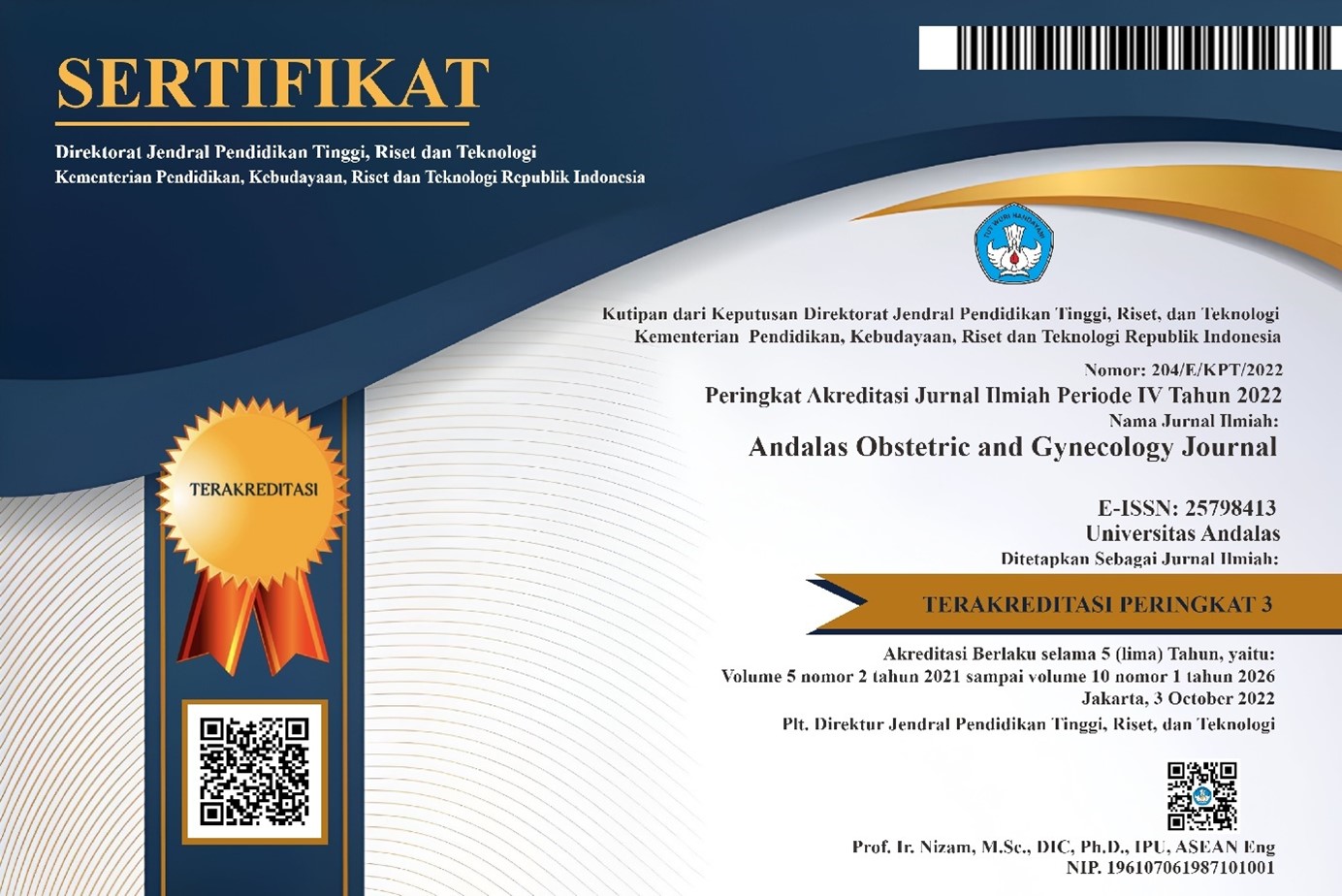The Mean Difference of Hemostatic Factors in Severe Preeclampsia and Eclampsia
DOI:
https://doi.org/10.25077/aoj.4.1.22-27.2020Abstract
The aim of this study was to see the difference in the mean ratio of sodium levels between pregnancy with severe preeclampsia and eclampsia. The method in this research is an analytical study using a cross sectional design. The research was conducted in the delivery room Dr. M. Djamil Padang from 15 January 2016 to 31 December 2017. There were 60 patients as research subjects, the sample was divided into 2 groups, namely severe preeclampsia (PEB) and eclampsia. Anamnesis and physical examination were then carried out to obtain data and clinical diagnosis. The data were recorded in a research form that had been provided, then the blood electrolytes were examined for sodium and potassium. Statistical analysis to assess meaning using the T-test. The results showed that in the PEB and Eclampsia groups, it was found that multiparity parity had the highest respondents. This is in accordance with the literature where the incidence of preeclampsia is more often found at gestational age near term. The conclusion of this study there was no significant difference in the mean sodium ratio between preeclampsia, PEB and eclampsia.
Keywords: pregnancy condition, PEB, eclampsia, platelet, PT, APTT, and D-DimerReferences
Cunningham, F.G et al. William Obstetrics 24nd. Pregnancy Hypertension. The McGraw-Hill Companies, Inc. New York; 2014. 706-756
Roeshadi HR. Hipertensi dalam kehamilan. Dalam : Ilmu kedokteran fetomaternal. Ed pertama. Himpunan Kedokteran Fetomaternal Perkumpulan Obstetri dan Ginekologi Indonesia. Surabaya, 2004: 494-500.
Sibai, Baha M. Diagnosis and Management of Gestational Hypertension and Preeclampsia. The American College of Obstetricians and Gynecologists Vol 102 No 1. Elsevier; July 2003
Baskett T. Disseminated Intravascular Coagulation (DIC) in Pregnancy. 2010.
Levi M. Disseminated Intravascular Coagulation (DIC) in Pregnancy and the Peri-partum Period. Department of Internal Medicine, Academic Medical Center, University of Amsterdam. Dalam: Trombosis Research 123 Suppl.2. The Netherlands: 2009. 563-4.
Stewart C. Disseminated Intravascular Coagulation (DIC). Australia Critical Care 2001; 14(2): 71-75
Widjaja, AC. Uji Diagnostik Pemeriksaan Kadar D-Dimer Plasma Pada Diagnosis Stroke Iskemik. Bagian Patologi Klinik Fakultas Kedokteran Universitas Diponegoro. Semarang: 2010
Denantika O, Serudji J, Revilla G, Hubungan Status Gravida dan Usia Ibu terhadap Kejadian Preeklampsia di RSUP Dr. M. Djamil Padang Tahun 2012-2013, Jurnal Kesehatan Andalas. 2015; 4(1):212-7
Madi J, Sulin. D. Angka kematian Pasien preeklampsia dan Eklampsia RS Dr M Djamil padang tahun 1998-2002. Bagian Obstetri dan Ginekologi FK Unand/RS Dr. M. Djamil. Padang.
Wiknjosastro, H. Ilmu Kebidanan. Yayasan Bina Pustaka Sarwono Prawirohardjo. Jakarta; 2008
Erez O, Novack L, Beer-Weisel R, Dukler D, Press F, et al. (2014) DIC Score in Pregnant Women – A Population Based Modification of the International Society on Thrombosis and Hemostasis Score. PLoS ONE 9(4)
Downloads
Published
Issue
Section
License
Copyright (c) 2020 Andalas Obstetrics And Gynecology Journal

This work is licensed under a Creative Commons Attribution 4.0 International License.
Copyright
Authors who publish with this journal agree to the following terms:
- Authors retain the copyright of published articles and grant the journal right of first publication with the work simultaneously licensed under a Creative Commons Attribution 4.0 International License that allows others to share the work with an acknowledgment of the work's authorship and initial publication in this journal.
- Authors are able to enter into separate, additional contractual arrangements for the non-exclusive distribution of the journal's published version of the work (e.g., post it to an institutional repository or publish it in a book), with an acknowledgment of its initial publication in this journal.
- Authors are permitted and encouraged to post their work online (e.g., in institutional repositories or on their website) prior to and during the submission process, as it can lead to productive exchanges, as well as earlier and greater citation of published work (See The Effect of Open Access).
License:
Andalas Obstetrics and Gynecology Journal (AOJ) is published under the terms of the Creative Commons Attribution 4.0 International License. This license permits anyone to copy and redistribute this material in any form or format, compose, modify, and make derivatives of this material for any purpose, including commercial purposes, as long as they credit the author for the original work.







